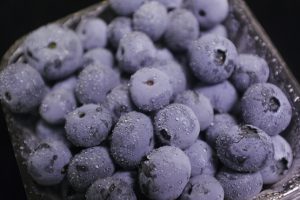
by Amy Mullins, PhD, RDN | Oct 9, 2020
By Matthew Poland and Amy Mullins, MS, RDN
For Floridians, getting enough sunlight during the winter may not be an issue that frequently crosses our sun-kissed minds. However, by spending winter vacation up north or by simply not spending the recommended 10-30 minutes per day outdoors, we could be putting ourselves at risk. In fact, it is estimated that between 20-80% of men and women from the US, Canada and Europe are vitamin D deficient, with rates as high as 45-100% of vitamin D deficiency in some places throughout Asia (1). Even though Florida seems to be as good as it gets for soaking in the sun, a 2005 study of residents of Miami found that between 38-40% were vitamin D deficient (2).
Vitamin D plays a much larger role in our health then we tend to realize. In addition to being a hormone responsible for regulation of bone metabolism, vitamin D has important functions in pregnancy, inflammation, cell growth, neurotransmitter production, immune and neuromuscular function, and glucose metabolism (3). Meanwhile, low vitamin D levels have been associated with increased risk for various diseases including cardiovascular disease, cancer, diabetes, and even an increased risk of mortality (1).

Go outside Photo Source: Matthew Poland
It is well known that sunlight exposure is the major source of vitamin D in our bodies, although some can be absorbed through our diet. However, as we spend less and less time outdoors, our risk of vitamin D deficiency steadily increases. On top of this, there are a variety of factors that can play a role in the ability of an individual to produce vitamin D including skin pigmentation, clothing, sunscreen, and of course where we live. In addition, a likely reason for such a high amount of Miami’s residents being vitamin D deficient is due to the smog levels of larger cities. Air pollution can absorb the UVB rays that our bodies convert into vitamin D, and prevent them from ever reaching us. Plus, in the wintertime, there is less sunlight to be had, which brings into play the next dangerous winter side effect: seasonal affective disorder, appropriately given the acronym, SAD.
While SAD may seem like a northern phenomenon, and it is with up to 9% of Alaska’s residents experiencing SAD compared to Florida’s 1%, it also involves the lack of sunlight during the winter (4). This lack of sunlight interferes with the body’s ability to regulate its circadian rhythm, the 24-hour internal clock that is typically synced with the light-dark cycles of our environment (4). Having shorter days and longer nights in winter is not unique to the north. With some Florida days offering only 10 hours of sunlight and indoor jobs that often consume 8 to 9 hours of our day, there is suddenly limited time to be in the sun (8). Vitamin D has been theorized to play a role in serotonin production, a neurotransmitter responsible for our feelings of well-being and happiness, and the insufficiency or deficiency of vitamin D has also been associated with clinical depressive symptoms (5). In summation, the lack of sunlight during the winter can create depressive symptoms and decreased absorption of vitamin D also leads to further depressive symptoms.
Although this self-perpetuating spiral of doom and gloom may be a bit of a downer, here are a few tips for getting through winter while keeping your vitamin D levels, circadian rhythm, and sanity in check:
- Go outside! Unfortunately, the angle of the sun in the wintertime reduces the availability of ultraviolet sunlight. It is important, however, to spend some time outdoors on sunnier days to allow for vitamin D synthesis, even if it’s not at optimal levels.(6).
- Eat a balanced, healthy diet consisting of a wide variety of foods. Although most foods don’t naturally contain vitamin D, wild-caught salmon and mushrooms being the exceptions, many foods like dairy are fortified with vitamin D (1). However, diet alone has been shown to be insufficient in providing vitamin D to children and adults in the US (7). If through food and sun, your vitamin D levels are not where they need to be, supplementation of around 1000 IUs per day can bring levels back to normal.
- Always talk with your healthcare provider before taking any dietary supplements. Have your vitamin D levels evaluated by your physician. Many people can go throughout life not knowing they are deficient in vitamin D until a broken bone necessitates testing.
So, with winter approaching, keep in mind the importance of being outside and eating well to feel your best as we roll into 2021!
Photo credit: Matthew Poland
Matthew Poland is a Graduate Student in the Department of Food, Nutrition, and Exercise Sciences at Florida State University who is currently working on the Dietetic Internship to become a Registered Dietitian/Nutritionist (RDN).
References:
- Hossein-nezhad, A., & Holick, M. F. (2013). Vitamin D for health: a global perspective. Mayo Clinic proceedings, 88(7), 720–755. https://doi.org/10.1016/j.mayocp.2013.05.011
- Levis S, Gomez A, Jimenez C, et al. Vitamin D deficiency and seasonal variation in an adult South Florida population. J Clin Endocrinol Metab. 2005;90:1557–1562.
- Vitamin D – Fact Sheet for Health Professionals. (2020, September 11). Retrieved September 17, 2020, from https://ods.od.nih.gov/factsheets/VitaminD-HealthProfessional/
- Melrose S. (2015). Seasonal Affective Disorder: An Overview of Assessment and Treatment Approaches. Depression research and treatment, 2015, 178564. https://doi.org/10.1155/2015/178564
- Kerr, D. C., Zava, D. T., Piper, W. T., Saturn, S. R., Frei, B., & Gombart, A. F. (2015). Associations between vitamin D levels and depressive symptoms in healthy young adult women. Psychiatry research, 227(1), 46–51. https://doi.org/10.1016/j.psychres.2015.02.016
- Webb, A. R., Kline, L., & Holick, M. F. (1988). Influence of season and latitude on the cutaneous synthesis of vitamin D3: exposure to winter sunlight in Boston and Edmonton will not promote vitamin D3 synthesis in human skin. The Journal of clinical endocrinology and metabolism, 67(2), 373–378. https://doi.org/10.1210/jcem-67-2-373
- Moore, C., Murphy, M. M., Keast, D. R., & Holick, M. F. (2004). Vitamin D intake in the United States. Journal of the American Dietetic Association, 104(6), 980–983. https://doi.org/10.1016/j.jada.2004.03.028
- Tallahassee, Florida, USA – Sunrise, Sunset, and Daylength, September 2020. (n.d.). Retrieved September 19, 2020, from https://www.timeanddate.com/sun/usa/tallahassee

by Angela Hinkle | Aug 10, 2020
You may be spending more time creating and experimenting in your kitchen these days. But are you taking the time to clean and enjoy the beauty of the kitchen when you’re not making those new culinary masterpieces? Here are 11 super simple kitchen cleanups that can take away the stresses caused by kitchen grime, stink, and clutter.
That’s Dirty!
- Dust and Cover
For space between upper cabinets and the ceiling, begin by using a duster (and soapy sponge if needed) to get rid of all those dust bunnies. Then lay down wax paper (which holds the dust) or newspaper, paper grocery bags, or parchment paper. Then you can just lift the old paper and put down new a few times of year without having to clean years of dust and grime by hand. You may want to start with this because dust may fall from the top. Then work your way down to the rest of the kitchen.
- Clean the Microwave
Add about one cup of water to a large microwave-safe bowl. Cut a lemon in half. Squeeze the lemon juice into the bowl then add the lemon halves too. Microwave on high for about 2 minutes until the liquid boils and the window steams up. Don’t open the door yet; let the bowl sit for about 5-10 minutes. The steam loosens the gunk. Then it’s just an easy wipe down with a sponge inside and out.
- Wipe Down Surfaces
Wipe cabinet shelves and doors, counter tops, and trashcans with warm soapy water. Use the rough side of a double-sided non-scratch sponge for stuck-on areas and the softer side for crumbs and easier messes. You can also disinfect these surfaces with a spray bottle filled with a solution of one tablespoon bleach to one quart water, using paper towels to wipe dry.

Ever Cleaned?
Photo: A. Hinkle
- Scrub a Stove-top

Clean/ready to cook.
Photo: A. Hinkle
First, wipe down with warm soapy water. Put half a cup of baking soda in a bowl. Then slowly pour in hydrogen peroxide, mixing until it becomes a thin paste. Pour a little paste on the stubborn spots and rub with a heavy-duty paper towel or rag. The stains should come right off. For stubborn stains, pour a bit more of the paste onto the stuck-on stain and let it soak for about 10 minutes. Then scrub, scrub, scrub some more until the stove-top is completely clean.
(Check manufacturer’s directions for smooth top stoves.)
- Wash the Refrigerator
Take out shelves, drawers, and other removable parts of your refrigerator and freezer and wash with hot water and dish soap – just as if they were dishes. Wash the inside walls and door compartments of the refrigerator and freezer with a solution of 2 tablespoons baking soda and 4 cups warm water to clean and reduce any strong odors. Rinse with clear warm water and dry with a soft cloth. Wipe off all jars and dishes as you replace them in the refrigerator.
Wash the outside of the refrigerator and freezer with hot soapy water, rinse, and dry. Don’t forget the door gaskets – sticky gaskets can cause air leaks, using more energy over time.
That Stinks!
- The Garbage Can
Sprinkle baking soda into the bottom of the trash bag to help keep the shudder-inducing smellies away and/or add a cotton ball soaked in essential oils to add a nice scent.
- The Stinky Sink
First, run hot water down the drain. Follow that with a cup of baking soda. Finish off with a cup of lemon juice. This fizzy reaction is fun to do with the kids.
- That Refrigerator Smell
Placing an open box of baking soda on a shelf in the refrigerator gets rid of most smells. If your unit has a pan or plastic tray on the very bottom to collect the condensation or defrost water, remove and clean it once or twice a year. Dust and moisture in this pan can lead to mold growth and cause health problems for persons with allergies. It also can develop an unpleasant odor. Check your care manual for the location of the pan.
That’s Got to Go!
- Food – Organize, Keep, Toss
Go through your refrigerator, freezer, and pantry and throw away anything that is expired, moldy, or you have no idea what it is. (To learn more about Use-By, Sell-By, and Best-By dates on food packages, check out Understanding Date Labels.) FIFO (First In First Out) your pantry foods by placing the older foods at the front and newer foods in the back. This way, you use up the foods that will expire first. Throw away any foods with freezer burn.
- Herbalicious…or Not
Toss out any herb or spice containers that are past their best-if-used-by date. Herbs and spices begin to quickly lose their wonderful tastes and aromas after this date. If it has no date and you have no idea how long you’ve had it, best bet is to throw it away.

That Kitchen Drawer
Photo Source: A. Hinkle
- That Drawer
Where is that ladle? I know I put it in this drawer. Why is the kitchen tool I want to use always at the bottom of the utensil (or junk) drawer? And why do I have five corkscrews when I don’t even drink wine? Help beat these frustrating dilemmas. De-clutter and organize this drawer. Start by taking everything out – yes, everything. Pick out things you never use. If you’ve had a melon baller for 10 years and used it once nine years ago, put it in a giveaway pile. Put four of the five corkscrews in that pile too. Throw away anything that’s broken or unusable. Wipe out the drawer using a sponge and warm soapy water or disinfectant wipes. Refill the drawer starting in the bottom/back with those tools you don’t use as often. Work your way forward and up with the tools you use most often. Ah, so much better now, and from now on.
Try tackling two or three of these tips a week. You can complete the whole list in one month. Your kitchen will be cleaner and more comfortable, and you can be less stressed and happier.

by Julie McMillian | Jun 22, 2020

Today’s Climate
Photo Source: UF/IFAS Photo Database
Many confuse the two words climate and weather. Weather is the day to day conditions of our atmosphere. Whereas, climate refers to the average of the weather over time. Weather depicts how we dress day to day and can change often. Climate refers more to the average weather over time. We generally must prepare for our climate by buying appropriate clothing and preparing our home for longer term weather conditions.
What causes the climate to change? There are three important greenhouse gases that have dramatically increased since industrialization: carbon dioxide, nitrous oxide and methane. The increases are primarily due to our changes in land use over time. These factors make our earth’s surface temperature warmer which affects our loss of sea ice and longer fire seasons, and can contribute to extreme weather events.

Adjust the temperature
Photo Source: Julie McMillian
The question is, what can I do in my own world and community to help on an individual basis? There are several ways that we can reduce our energy use of electricity at home which will help us to contribute to the bigger picture. Some simple suggestions are when you are not using the television, computer, lights, heating and cooling, try to turn them off or down for a while. Purchasing shades or curtains for your windows can keep your house cooler in the summer and fans may be able to replace the air conditioner on some occasions. When running the air, heat or hot water heater check your thermostat for energy saving features. Try to only run the dishwasher or washing machine with full loads and be sure to clean out your lint trap in the dryer so it has good airflow. You will find you might even save a few dollars by being mindful of your energy consumption.
Next, let’s talk about reducing greenhouse gases in our yards. Composting food scraps is a great way to reduce waste from landfills and turns your waste into reusable soil. Planting trees and plants helps to reduce carbon dioxide in the atmosphere. Plants store carbon and help to regulate temperatures in the home. Another thing to consider is, where does your water run off go? If water can be routed to your garden it is a win-win.
How do we plan our food system in our home? Reducing food waste has many benefits. We can save money, help our community, conserve energy and resources just by rethinking the way we plan our meals. If we buy more unprocessed foods, there will be less packaging. If we are able to grow our own food or just eat at home more, it cuts down on trips to restaurants and stores.
These are just a few ways to get you thinking about climate change in Florida. As a citizen, we can take action by staying informed and showing our support. If we hold ourselves accountable by looking at our personal impact, we may be surprised what we are leaving behind with our footprint. For more information on healthy living or other extension related topics, contact your local UF IFAS county extension office.
Supporting information for this article can be found in the UF/IFAS Extension EDIS publications:
Science Support for Climate Change Adaptation in South Florida
Climate Change Adaptation: New Perspectives for Natural Resources Management and Conservation
Energy Efficient Homes
UF/IFAS Extension is an Equal Opportunity Institution.

by Samantha Kennedy | May 11, 2020
We like to feel as if we are always in control of our lives, especially during a crisis. Being in control provides us with feelings of confidence and strength, as if nothing could ever go wrong. However, sometimes we are not in control of our lives. Sometimes our emotions can run away with us and in times of confusion and uncertainty, those emotions can leave us feeling scared and anxious.
Right now, for many of us, our world has tilted a bit off its axis. We feel as if life is a little precarious, as if the control we value has been threatened. We want to protect ourselves and our families from something we may not fully understand, and this can leave us feeling a bit helpless. While this can be a scary way to feel, let me just say this: It is okay to feel this way, especially during times of challenge and uncertainty.
The key to keeping steady on rough emotional seas is to seek out feelings of calm. Seek out activities that can help distract from the anxious feelings, even for a few minutes. Soothing activities can vary depending on the person, so it is important to find which activities work best. Here are some good examples:

A good book and a soothing cup of tea can provide an oasis of calm in a desert of uncertainty. (Photo source: Samantha Kennedy)
Reading. Books and stories can be a great escape, allowing us to get lost in a world where there are no problems or where, at the very least, the problems are not ours to worry about. When I am feeling anxious, I like to dive into a good mystery or thriller where my mind can become occupied with an intricate plot and I can break the cycle of worried thoughts swirling inside my head. Reading stories with children can help everyone take a break from stress as well.
Creating. Remember those adult coloring books we all bought years ago? Pull those out of the drawer and blow the dust off them. Those items were touted as good stress busters for a reason. Concentrating on coloring in a picture or a pattern can help calm the mind and alleviate stressful emotions. Other creative outlets work just as well, such as drawing, journaling, or playing the guitar. I enjoy practicing my hand lettering when I am feeling stressed.
Exercising. Moving our bodies infuses our muscles and brain with oxygen and releases those feel-good chemicals known as endorphins, which produce feelings of relaxation and euphoria. Exercise strengthens our bodies and boosts our emotions. The exercise does not have to be strenuous to be effective. Low-impact exercise such as yoga and tai chi can have as much of a positive effect on the mind and body as more intense exercise such as running and weightlifting.
Meditating. Meditation is often thought of as something only practiced by spiritual folks on mountaintops in Tibet. But this is an unfair stereotype. Meditation can be practiced by anyone, even children. At its most basic, it is simply a way to center and calm our mind by focusing on our breath as it moves in and out of our body. By doing this, we can simply acknowledge and quickly dismiss all extraneous thoughts, including anxious and stressful ones, thereby not allowing them to take hold. Effective meditation takes practice, but it does not have to take a long time. Even a short 5-minute meditation can help us find calm in a sea of chaos.
Finding ways to achieve calm during confusing times can help us feel more in control of our lives and can reduce feeling of stress and anxiety. For more suggestions on how to cope with stress, please read the UF/IFAS fact sheet Stress Management: Ways to Cope.
Extension classes are open to everyone regardless of race, creed, color, religion, age, disability, sex, sexual orientation, marital status, national origin, political opinions or affiliations.

by Dorothy C. Lee | May 11, 2020
Once known as star berries because of the pointy flower calyxes on top, blueberries have grown wild in North America for thousands of years. They were a staple among Native Americans, who dried and smoked the berries, and pounded them into venison to flavor the meat.

Berries such as blueberries are rich in vitamin, minerals, and antioxidants and can be delicious additions to yogurt, salads, and smoothies. (Photo source: UF/IFAS file photo)
Uses & Preparation
Wash blueberries just before using. Add to yogurt or cottage cheese or any fruit and mild cheese platter. For color and great taste, add to salads; or sweeten pancakes, cakes, and muffins.
Selection
Look for firm, dry, plump, smooth-skinned berries with a light grayish bloom. Ripe berries should be deep-purple blue to blue-black.
Storage
Cover and refrigerate fresh berries for up to 10 days. Blueberries are easily frozen for later use. Freeze unwashed blueberries in airtight, resealable plastic bags. If thawed, keep refrigerated and use within 3 days.
Blueberry Pancake Stacks
Vegetable Oil for cooking
1 cup milk
1 tablespoon vegetable oil
1 egg
1 cup all-purpose flour
1/2 teaspoons baking powder
1 teaspoon salt
1 cup fresh blueberries
Dash of nutmeg
In a mixing bowl, stir together the milk, oil, and egg. In a separate bowl, combine the flour, sugar, baking powder, salt and nutmeg. Add dry ingredients to the milk, and stir just until mixed (batter should be slightly lumpy). Gently fold in the berries. Spoon the batter onto a griddle or pan greased with vegetable oil and heated to medium-hot (dollops should be about the size of a silver dollar). Let the batter cook until the tops of the pancakes begin to bubble, then flip and cook until done. Stack and serve immediately with softened margarine and warm syrup. Makes about eighteen 2 1/2″ pancakes.
Blueberry Syrup
Combine 1 pint of blueberries and 1 cup of maple syrup in a saucepan. Heat to boiling, then lower the heat and simmer until most of the fruit has burst. Remove from heat and use a fork to mash the berries. The syrup will thicken as it cools. Store in the refrigerator for up to 2 days.
Nutrition Information: Good source of vitamin C. High in fiber. Low in calories.
Available Fresh: April – June
To learn about fresh Florida strawberries, please read our fact sheet: Panhandle Produce Pointers – Blueberries.
.For more delicious produce preparation tips, please visit: http://www.panhandleproducepointers.com.
UF/IFAS Extension is an Equal Opportunity Institution.

by Julie McMillian | May 11, 2020
What does your morning and evening routine consist of? Now that we are adjusting to our new normal of staying at home and social distancing, many routines are different than before. How about starting a routine of walking 30 minutes or an hour each day? There are so many positive benefits to even just adding 15 minutes to your schedule and most everyone, including children, can do it.

Walking is a great form of exercise that nearly everyone can do. (Photo source: Lyon Duong, UF/IFAS)
Walking improves your mood and reduces stress and anxiety. Who doesn’t need that kind of positive influence in their life right now? If you walk in the morning, it will provide you with energy for the rest of the day and walking in the evening helps you to sleep better at night. Taking a few extra steps each day can add some time to clear your head and add to your energy level while creating a positive mindset for other activities.
One of the other benefits of walking is burning calories. Burning calories may lead to weight loss. It seems that almost every American is always looking for a way to improve the fitness of their body. By exercising during a walk, you build stronger muscles, ligaments and tendons. Physically, walking can reduce your hips, tighten abdominal muscles, strengthen your arms, and tone your legs. Walking gives you a chance to improve balance, coordination and flexibility. Your feet can help to reduce the load on other joints while keeping knee joints healthy and lowering the risk of blood clots. Walking makes your heart stronger and reduces risk of stroke. A research team from the University of Michigan Medical School says that people who are in the 50s-60s age bracket who exercise regularly are 35 percent less likely to die in the next eight years than those who do not. Therefore, some walking each day could help you lead to a longer life.
Now that we have so many reasons to take a stroll each day, we must make sure to walk correctly to avoid injury. It is important to move freely and naturally while swinging your arms to avoid back problems. Keep your shoulder back with your head held high and eyes forward. Position your feet straight and push off with your hind leg to engage your hips. Watch for traffic if you are walking by a highway and of course practice social distancing for now. Maybe later ask a friend to join for a social aspect and to have accountability to someone. Keep a log to track progress. The CDC recommends 150 minutes of moderate activity per week to be considered active adults. That should add up to about 7,000 to 8,000 steps a day but if you can get 10,000, go for it! It is a great time to get into this daily routine and doesn’t require any special equipment or memberships.
So what are you waiting for? There is no better time to start stepping.
For more information on healthy living or other extension related topics, contact your local UF/IFAS Extension Agent.
Additional Resources:
Healthstyle: A Self-Test (UF/IFAS Extension)
Healthy Living: Beating Barriers to Physical Activity (UF/IFAS Extension)
Improving Savings, Health, and Happiness by Modifying How the Family Operates the Home (UF/IFAS Extension)
Walking: Your Steps to Health (Harvard Health)
UF/IFAS Extension is an Equal Opportunity Institution.















